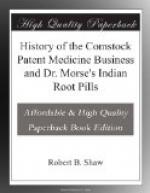The repetition of his name suggests that J. Carlton was the principal inventor of his firm’s remedies.
Suits and Countersuits
All of the foregoing changes in name and business organization must have been highly confusing to the wide array of agents and retail druggists over many states and the provinces of Canada with whom these several firms had been doing business. And when George Wells and J. Carlton split off from Lucius and established their own office down the street, it was not at all clear who really represented the original Comstock business, who had a right to collect the numerous accounts and notes still outstanding, and who owned the existing trade names and formulas. Dispute was inevitable under such circumstances, and it was aggravated by Lucius’ irascible temper. Unfortunately for family harmony, these business difficulties also coincided with differences among the brothers over their father’s will. Samuel had died in 1840, but his will was not probated until 1846; for some reason Lucius contested its terms. There had also been litigation over the estate of Edwin, the elder brother.
With the inability of the two parties to reach friendly agreement, a lawsuit was initiated in June 1850 between Lucius on the one hand and J. Carlton and George Wells on the other for the apportionment of the property of Comstock & Co. Brothers, which was valued at about $25,000 or $30,000. Subsequently, while this litigation was dragging on, Lucius found a more satisfying opportunity to press his quarrel against his brothers. This arose out of his belief that they were taking his mail out of the post office.
On May 26, 1851, one of the New York newspapers, the Day Book, carried the following item:
United States Marshal’s Office—Complaint was made against J. Carlton Comstock and Geo. Wells Comstock, of No. 9 John Street, and a clerk in their employ, for taking letters from the Post Office, belonging to Dr. L.S. Comstock, of 57 in the same street.
Dr. Comstock having
missed a large number of letters, on inquiry at
the Post Office it was
suspected that they had been taken to No. 9
John Street.
By an arrangement with the Postmaster and his assistants, several letters were then put in the Post Office, containing orders addressed to Dr. Comstock, at 57 John Street, for goods to be sent to various places in the city to be forwarded to the country. The letters were taken by the accused or their clerk, opened at No. 9, the money taken out and the articles sent as directed, accompanied by bills in the handwriting of Geo. Wells Comstock. Warrants were then issued by the U.S. Commissioner and Recorder Talmadge, and two of the accused found at home were arrested and a large number of letters belonging to Dr. C. found on the premises. J.C. Comstock has not yet been arrested. It is said he is out of the city.
These two young men
have for some months been trading sometimes
under the name of “Comstock
& Brother”, and sometimes as “Judson &
Co.” at No. 9
John Street.




